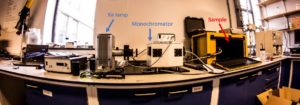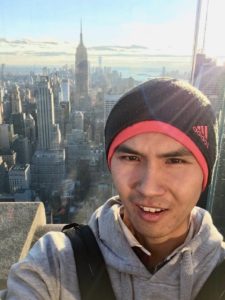Recalling my early days as a PhD student, our lab was just setting up equipment for tests, which involved a group of devices that could evaluate the efficiency of our electrodes for splitting water into hydrogen and oxygen using sunlight. For that, we needed a “sun” in the lab to give out consistent irradiation, which was a powerful Xe lamp (Fig. 1). Only when our sample electrodes were illuminated with this big bulb would they get excited, generate electric current and produce gas.
The more interesting part was, however, something called a monochromator. When I was doing physics module as an undergraduate and first came across this instrument in textbook, I mumbled, ‘What’s the big deal?’ But as different colours of light came out one after another in front of my eyes (with special safety goggles on, of course), it was like seeing some kind of magic unfolding. This was even cooler than ‘The Dark Side of The Moon’! But what the expensive monochromator really did was to allow us to evaluate how well our samples respond to each wavelength of light, technically called incident photon-to-current conversion efficiency (IPCE).
Another measurement we did was called intensity modulated photocurrent spectroscopy (IMPS), which has been gaining increasing popularity over the years. This test involved superimposing an AC signal on a DC signal and giving it as input to an LED so that the light intensity changed sinusoidally around a constant level. When the experiment started and you would see the light start to jiggle, at all sorts of frequencies from kHz to mHz, just like stage lights. Suddenly, we were like: It’s party time! Now back to business, we had to take recordings of the current generated by our electrodes and calculate a couple of rate constants to understand the kinetics of the water splitting reaction.
These fun experiments led our group to a number of publications (1, 2), including one in RSC Advances. Moving on to a different university as a postdoc, I’m planning to buy them again!

Fig 1. Lab setup at University of Bath (2017). Now at Imperial College London under group of Salvador Eslava.
References
1. J. Zhang et al., RSC Adv., 2017, 7, 35221
2. J. Zhang et al., Energy Environ. Sci., 2018, 11, 2972
About the Web Writer:
 Jifang Zhang completed his BEng at Beijing Institute of Technology, before moving to the UK for MSc at the University of Edinburgh and PhD at University of Bath. Now he is back in Beijing as a postdoc researcher at Tsinghua University.
Jifang Zhang completed his BEng at Beijing Institute of Technology, before moving to the UK for MSc at the University of Edinburgh and PhD at University of Bath. Now he is back in Beijing as a postdoc researcher at Tsinghua University.
Outside working hours, he is always juggling between karate, running, drumming and photography. You can find him on Instagram @jifang_zhang.
 Submit to RSC Advances today! Check out our author guidelines for information on our article types or find out more about the advantages of publishing in a Royal Society of Chemistry journal.
Submit to RSC Advances today! Check out our author guidelines for information on our article types or find out more about the advantages of publishing in a Royal Society of Chemistry journal.
Keep up to date with our latest HOT articles, Reviews, Collections & more by following us on Twitter. You can also keep informed by signing up to our E-Alerts.










